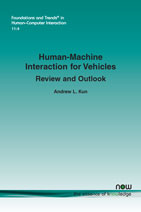Human-Machine Interaction for Vehicles: Review and Outlook
By Andrew L. Kun, University of New Hampshire, USA, andrew.kun@unh.edu
Abstract
Today’s vehicles have myriad user interfaces, from those related to the moment-to-moment control of the vehicle, to those that allow the consumption of information and entertainment. The bulk of the research in this domain is related to manual driving. With recent advances in automated vehicles, there is an increased attention to user interactions as they relate to automated vehicles. In exploring humanmachine interaction for both manual and automated driving, a key issue has been how to create safe in-vehicle interactions that assist the driver in completing the driving task, as well as to allow drivers to accomplish various non-driving tasks. In automated vehicles, human-machine interactions will increasingly allow users to reclaim their time, so that they can spend time on non-driving tasks. Given that it is unlikely that most vehicles will be fully automated in the near future, there are also significant efforts to understand how to help the driver switch between different modes of automation. This paper provides a review of these areas of research, as well as recommendations for future work.
Human-Machine Interaction for Vehicles: Review and Outlook
Human-Machine Interaction for Vehicles: Review and Outlook surveys and explores the significant and growing body of research on the topic of modern in-vehicle user interfaces.
Today’s vehicles have myriad user interfaces, from those related to the moment-to-moment control of the vehicle, to those that allow the consumption of information and entertainment. The bulk of the research in this domain is related to manual driving. With recent advances in automated vehicles, attention has increasingly focused on user interactions. In exploring human-machine interaction for both manual and automated driving, a key issue has been how to create safe in-vehicle interactions that assist the driver in completing the driving task, as well as to allow drivers to accomplish various non-driving tasks. In automated vehicles, human-machine interactions will increasingly allow users to reclaim their time, so that they can engage in non-driving tasks. Given that it is unlikely that most vehicles will be fully automated in the near future, there are also significant efforts to understand how to help the driver switch between different modes of automation.
Human-Machine Interaction for Vehicles: Review and Outlook reviews the key findings from this line of research, as well as recommending areas for future work. It is an ideal primer for researchers and user interface designers working in the area.
